In this interview series, we bring you insights from top industry professionals. Today, we sit down with Katarzyna Szymańska, Shopping Centre Director at Matarnia Retail Park, part of Cushman & Wakefield. Katarzyna shares her perspective on the ever-evolving commercial real estate market, stressing the need for a comprehensive approach to leasing, property development, and management. She highlights the impact of recent global events, the rise of e-commerce, and shifting consumer preferences on the industry. Katarzyna discusses the primary challenges faced by shopping centers, including adapting to changing customer behaviors and maintaining a flexible offering. She also emphasizes the critical role of technology in enhancing customer experiences and operational efficiency.
Despite these challenges, Katarzyna remains optimistic about the future, envisioning malls as multifaceted destinations that seamlessly integrate shopping, entertainment, dining, and sustainability.
Malls Interview – Technology in Shopping Centers
First of all, analyze the current situation… How are you living it?
The situation in the commercial real estate market is invariably dynamic, and this should motivate all players in the sector to take an even more holistic approach to both leasing, developing property portfolios and, ultimately, managing them. The recent years of market development, along with the rise of e-commerce, evolving consumer preferences, and not to mention the impact of the pandemic and the political-economic situation, have all contributed to making the operation of commercial properties a multidisciplinary field.
As the manager of the largest retail park in northern Poland, Matarnia, I actively analyze the current situation and trends shaping the market. This way, together with my team, I am able to adapt strategies to meet evolving consumer demands, and prioritizing the creation of a safe and engaging shopping experience. In my case, such high market dynamics and evolving consumer demands only positively spur me to keep going.
What is the biggest problem or weakness that a shopping center has to face?
This is undoubtedly a necessity to prepare a flexible, agile offer for the customer. Nowadays, customers have endless shopping options, thanks to the ever-growing popularity of online sales and the development of other trends, including the reuse of certain products. Shopping habits have changed; customers are more aware and knowledgeable about their shopping options and their own limitations, which influence their prioritization of key parameters – price, quality, and a wide range of choices. This translates into expectations for commercial properties. Customers no longer just expect a wide range of products but also engaging propositions for spending time in the commercial property. Shopping centers and retail parks have become destinations not only for shopping and entertainment but also for spending time, which makes the proper adjustment and modification of the offer, infrastructure, and management of such properties crucial.
Moreover, as highlighted in the latest Cushman & Wakefield report, “UX Retail in Poland“ Polish consumers have clearly defined expectations for each retail format, with each format addressing different shopping (and other) needs. According to the report, about 60% of Polish consumers choose shopping centers for their entertainment offerings, while nearly 40% opt for retail parks due to their familiarity with the space, which ensures efficient and quick shopping. Among the attributes that respondents consider to determine the attractiveness of a retail property, a large selection of available stores tops the list. An appropriate tenant mix is important for nearly 70% of respondents. Slightly lower scores were given to easy access and good infrastructure, as well as free parking at the property (both at 63%). More than half, 56% of consumers, value proximity to home (no more than a 15-minute drive from their residence). The food and beverage offerings also scored highly (almost 40%), and 1 in 5 individuals highlighted the entertainment offerings, indicating that a significant portion of respondents visits retail properties not only for shopping.
Currently, the biggest challenge or weakness that shopping centers face is understanding the needs and changes in customer behavior. This requires continuously adapting the offer, introducing innovations, ensuring unique experiences, and differentiating shopping centers to attract and retain customers. Additionally, the fact that we all operate in very uncertain times presents a significant challenge.

What role does technology play? How does it help a Shopping Center in the current situation? Would you highlight any in particular?
Technology plays a crucial role in helping shopping centers thrive in the current landscape. We are still at the beginning of this journey and tech solutions will be constantly evolving. At Cushman & Wakefield we are developing solutions for targeted marketing, data analytics, streamlined operations, and enhanced customer experiences. Specific technologies such as digital signage, mobile apps for navigation, smart parking solutions, and personalized offers are particularly instrumental in improving operational efficiency and creating a seamless and engaging shopping experience for customers. Key in all of this, of course, are solutions based on the use of AI technologies, which have unlimited potential.
How do you achieve customer loyalty now? What do you think this customer is looking for? How can we offer them an optimal experience?
Loyalty levels vary depending on the market and type of retail format, but it is definitely an area that requires our focus. Customers now have unlimited access to information, are demanding, and have increasingly specific visions of their needs, expectations, and the products and services they dislike and will not be convinced to use. Achieving customer loyalty in today’s retail environment involves delivering personalized experiences, convenience, sustainability, and community engagement. Customers seek more than just transactional relationships; they desire tailored experiences, meaningful interactions, and seamless omni-channel shopping experiences.
To foster customer loyalty, shopping centers can focus on implementing strategies like personalized marketing, loyalty programs, community events, and exceptional customer service to offer customers an optimal and memorable shopping experience. With such widely available and diverse product and service offerings, customer loyalty is one of the key areas to work on, which includes the necessity of clearly distinguishing the retail property from competing properties.

Are you optimistic about the future of this sector? What do you think the mall of the future will be like?
Despite the challenges, I remain realistically optimistic about the future of the retail real estate market. The mall of the future is poised to be a multifaceted destination that integrates shopping, entertainment, dining, and experiential elements with offerings for spending time. It will prioritize creating immersive and interactive environments that blur the lines between online and offline shopping.
We must remember that many retail properties have been on the market for many years, and this should compel their owners to undertake modernization efforts, reposition their offerings, diversify their functions, and enhance their sustainable and eco-friendly characteristics. ESG is one of the universal trends for the entire commercial real estate market. The future mall will leverage technology, sustainability initiatives, and community spaces to evolve into a dynamic hub offering unique experiences and value to customers.
Navigating the Future: Challenges and Trends for Shopping Centers in 2024
Certainly, there will be additional areas worth expanding further. Consistency, authenticity, and regularity in the conducted activities are crucial. A trend that should not be overlooked by the largest and most popular brands in Poland is the development of retail parks. This format has completely dominated the market for about four years – currently, this type of assets accounts for 76% of the retail space under construction. Over time, we should witness the expansion of retail park offerings to become more complementary to the shopping center format. While they may not be direct competitors to shopping centers, they will certainly expand and enrich the broad range of options available to Polish consumers.







